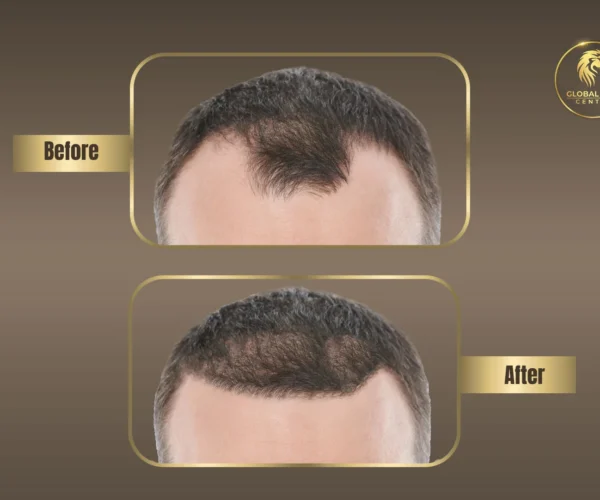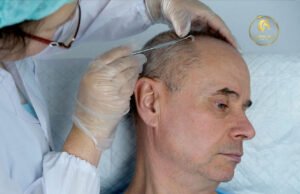What To Expect After a Hair Transplant in Dubai

What To Expect After a Hair Transplant in Dubai
After undergoing a hair transplant in Dubai, whether it’s for scalp hair or eyebrows, there are several key aspects to consider regarding what to expect during the recovery and subsequent phases. Here’s a comprehensive guide to help you understand the journey after a hair transplant procedure in Dubai.
Immediate Post-Procedure Care
Post-procedure care for hair transplants is the same for almost all of its types such as beard hair transplants or female hair transplants. However, the aftercare might change slightly from one technique to the other such as FUT or FUE.
Immediately after your hair transplant procedure in Dubai, it’s crucial to follow specific care instructions provided by your healthcare provider to promote healing and optimize results, including:
- Bandaging and Post-Procedure Instructions
You may have bandages or a surgical cap over the treated area to protect it from external factors. Your doctor will provide instructions on when to remove these and how to care for the area. - Medications and Pain Management
Your doctor may prescribe medications to prevent infection and manage any discomfort. It’s essential to take these as directed and avoid any medications or supplements that could interfere with the healing process. - Rest and Recovery
Rest is essential during the initial days after your hair transplant. Avoid strenuous activities, heavy lifting, and exposure to direct sunlight or extreme temperatures that could affect the treated area.
Early Recovery Phase (Days 1-7)
During the first week following your hair transplant in Dubai, you’ll likely experience some common post-operative effects, such as:
- Swelling and Redness: Swelling and redness around the transplanted area are normal and typically subside within a few days. Your doctor may recommend gentle massage or ice packs to help reduce swelling.
- Scabbing and Crusting: Small scabs or crusts may form around the transplanted hairs. It’s essential to avoid picking or scratching these areas to prevent dislodging the grafts.
- Hair Shedding: Within the first few weeks, the transplanted hairs may shed temporarily. This is a natural part of the hair growth cycle and doesn’t indicate treatment failure. New hair growth will begin in the following months.
Your doctor will schedule follow-up visits to monitor your progress, remove any non-permanent sutures or staples, and provide additional care instructions as needed.
Weeks 2-4
As you transition into the second to fourth weeks post-procedure, you may notice changes in the treated area. Here is what to expect during this phase:
- Healing Progress: The initial healing phase continues, with any redness and swelling gradually diminishing. The transplanted area may still appear slightly pink or numb, which is normal and will improve over time.
- Resuming Normal Activities: You can typically resume light activities and work duties, although it’s essential to continue avoiding strenuous exercise, swimming, or activities that could expose the area to excessive moisture or irritation.
- Growth of Existing Hair: Existing hair in the transplant area may temporarily shed due to shock loss, a common occurrence after hair transplantation. This is temporary, and new hair growth will begin as the follicles enter the growth phase.
Months 1-3
During months one to three, you’ll notice gradual changes and initial signs of new hair growth, they will look like this:
- Early Growth Phase: New hair growth begins to emerge from the transplanted follicles. Initially, the hairs may be fine and sparse, but they will thicken and become more visible over the coming months.
- Patience and Maintenance: It’s crucial to remain patient during this phase as hair growth varies among individuals. Continue following your doctor’s recommendations for hair care and avoid exposing the transplanted area to unnecessary stress or trauma.
- Cosmetic Camouflage: Some individuals may opt for cosmetic camouflage techniques, such as hair fibers or camouflage creams, to enhance the appearance of the hair during the initial growth phase.
Months 4-6
By months four to six post-procedure, significant progress in hair growth and density becomes noticeable. Here is what to expect during this time:
- Visible Results: The transplanted hair continues to grow and mature, resulting in improved density and coverage of the treated area. You may begin to see more natural-looking results as the new hair blends with existing hair.
- Hair Care Routine: Establish a regular hair care routine recommended by your doctor, including gentle shampooing and conditioning to maintain scalp health and promote optimal hair growth.
- Assessment and Adjustment: Your doctor may assess your progress and make any necessary adjustments or recommendations for continued hair growth and maintenance.
Months 7-12
During the final stages of the first year after your hair transplant in Dubai, you’ll experience continued improvements and stabilization of hair growth. This is the phase where you’ll most probably get the desired results. Here is what happens during this time:
- Full Growth and Density: By the end of the first year, most patients achieve full growth and density of the transplanted hair. The hair texture and appearance will continue to refine over time.
- Hair Care and Styling: You can resume normal hair care practices, including styling and trimming if desired. However, it’s important to avoid excessive heat or chemical treatments that could potentially damage the hair follicles.
- Long-Term Maintenance: Long-term maintenance of your transplanted hair involves regular follow-up visits with your doctor to monitor growth, assess any further hair loss concerns, and discuss options for additional treatments or enhancements if needed.
Beyond 12 Months
Beyond the first year post-procedure, the focus shifts to maintaining the results achieved from your hair transplant in Dubai. Here is what to expect after you get the final results:
- Stable Results: The transplanted hair remains permanent and continues to grow naturally alongside your existing hair. Continued care and maintenance are essential to preserve the results for years to come.
- Hair Growth Cycle: Understand that hair growth follows a natural cycle of shedding and regrowth. Your doctor can provide guidance on managing these cycles and maintaining optimal hair health.
- Follow-Up Care: Continue scheduling periodic follow-up visits with your doctor to monitor long-term progress, address any concerns, and receive recommendations for maintaining the health and appearance of your hair.
Conclusion
Undergoing a hair transplant in Dubai is a transformative journey that requires careful consideration and commitment to post-procedure care. By understanding what to expect at each stage, from immediate post-procedure care to long-term maintenance, you can ensure optimal healing, natural-looking results, and sustained hair growth. Contact Us to consult with a qualified healthcare provider at Global Hair Dubai to embark on your journey towards renewed confidence and enhanced hair aesthetics with confidence.

Top 5 Hair Transplant Centers in.
Dubai has become a leading destination for hair transplant surgery, attracting patients from across the Middle East and beyond. With.
Read More
Breaking Myths: Debunking Common Misconceptions About.
Breaking Myths About Hair Transplant Procedures Hair loss can be a distressing experience, impacting one’s self-esteem and confidence. Fortunately, advancements.
Read More

